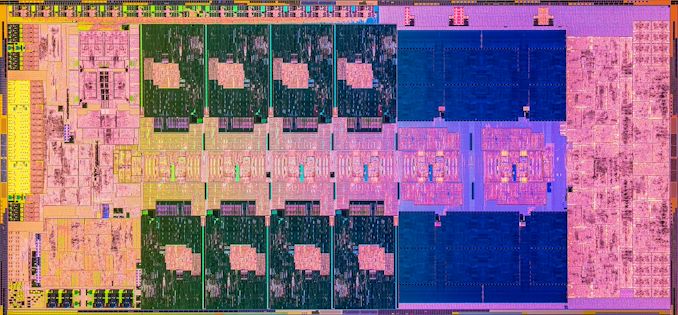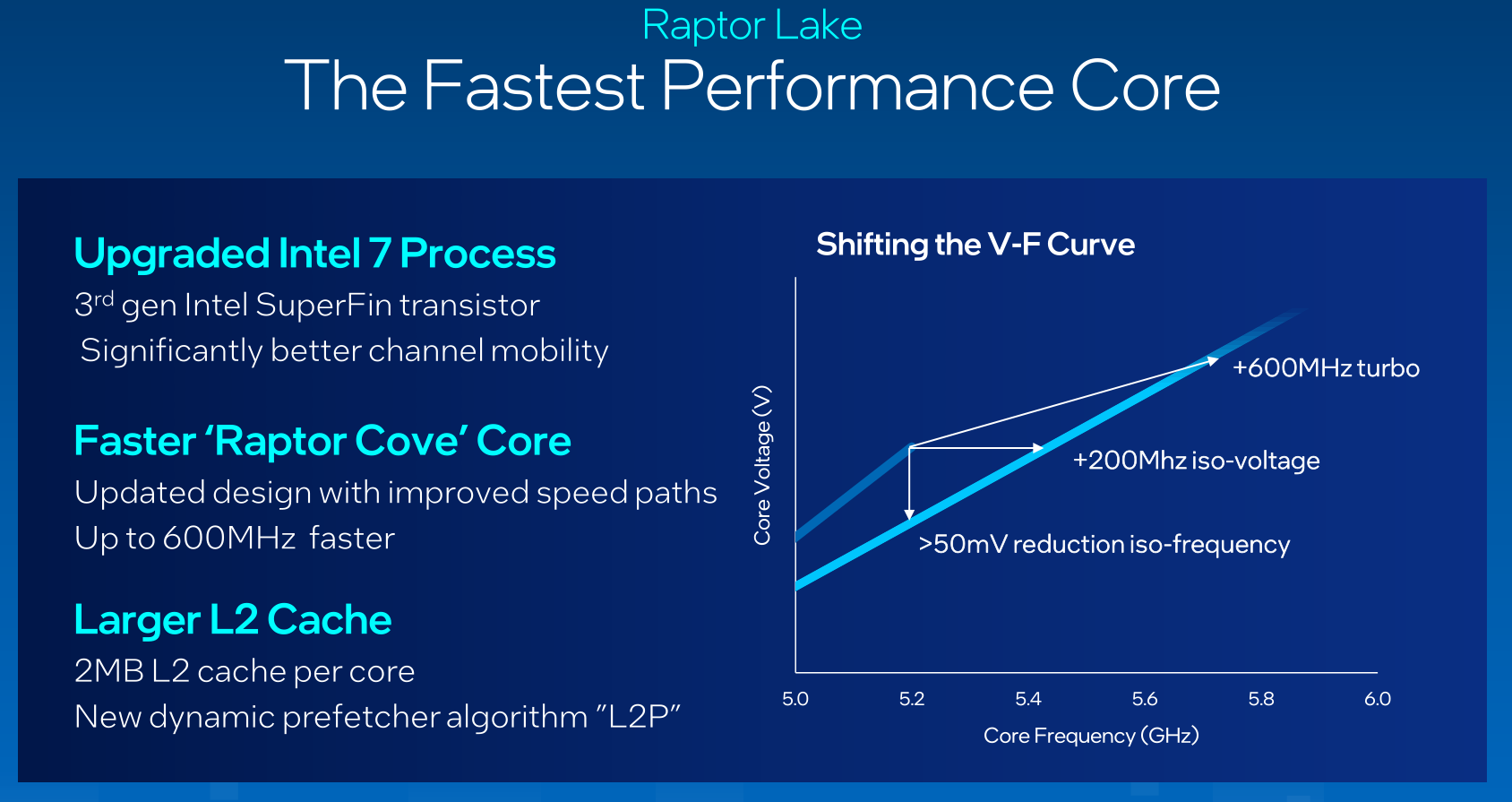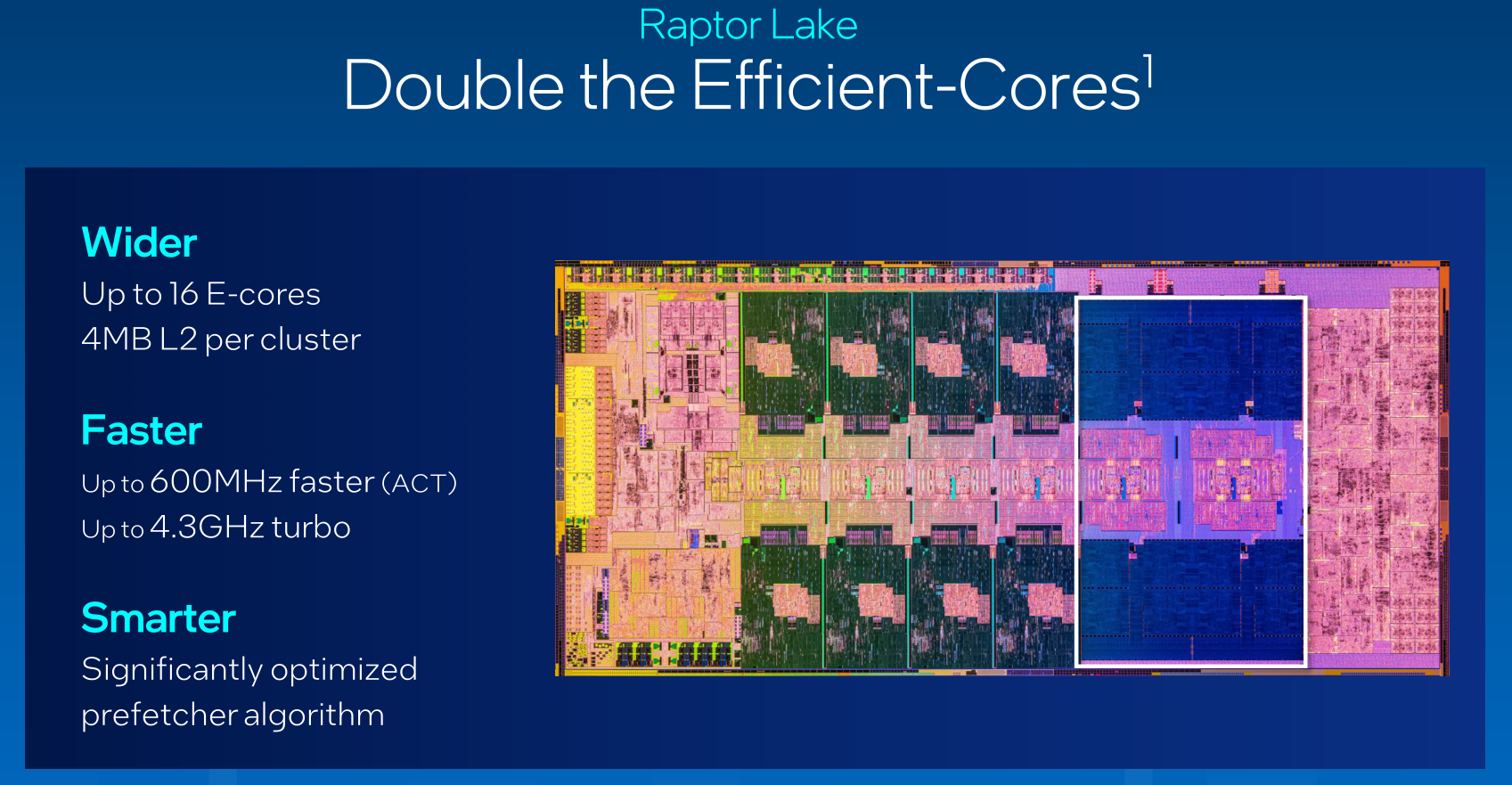Intel Core i9-13900K and i5-13600K Review: Raptor Lake Brings More Bite
by Gavin Bonshor on October 20, 2022 9:00 AM ESTRaptor Lake In Detail: Raptor Cove P-Cores, More Efficiency Cores
When it comes to architecturally dissecting the differences between Intel’s Alder Lake and Raptor Lake processors, both are based on a similar process. Intel’s 12th Gen Core (Alder Lake) series and the latest 13th Gen Core (Raptor Lake) are based on its Intel 7 manufacturing processor, although this isn’t to be confused with 7 nm, as Intel 7 is a 10 nm process node. This means that Raptor Lake isn't a new core so to speak, especially not a redesign of its existing 10ESF core, but more augmentation. Intel has opted for improvements to its underlying memory and cache structures.

Intel Raptor Lake Core die image (Core i9-13900K)
The new Raptor Cove performance (P) cores replace the previous Golden Cove variants, with Intel specifying that Raptor Cove is based on an ‘enhanced’ version of its Intel 7 process using its 3rd generation of SuperFin transistor. With this newly optimized process combined with a better overall VF curve over the last age, Intel hopes to leverage the benefit from a higher frequency without increasing power levels too much.
Focusing on changes to the cache, the 13th Gen Core series has more L2 cache. For the new Raptor Cove core, Intel has added more L2 cache when compared to Alder Lake, with 1.6x more with 2 Mb per P-core. The levels of L2 cache assigned to each array of E-cores now equates to 4 Mb; up from 2 Mb. This means Intel has improved the L2 cache on both core types. For the L3 cache, Intel hasn't made any strides and has left things unchanged.
Adjusting to the Voltage Frequency (VF) cure has allowed Intel to squeeze out even more gains about frequency versus voltage. In the case of Raptor Lake, Intel has managed to increase the peak P-Core frequency by a significant amount, up to 1 GHz in some cases. An example is the Core i9-13900K which has a maximum turbo frequency of up to 5.8 GHz; this equates to just over 11.5% over the Core i9-12900K. As per the released V/F curve optimizations, Intel has managed to eke out 200 MHz at ISO-Voltage, with a reduction of 50 mV at ISO frequency.
One thing to highlight about Intel’s 13th Gen Core series processors is the discrepancy between the base TDP, which for its entire launched stack (as of 10/20) is 125 W. The turbo or PL2 values are the same for the Core i9 and Core i7 models which are set at 253 W. This is an increase of 12 W from the corresponding 12th Gen Core i9 chips (241 W), and up by 63 W on the Core i5 series like for like. With the element of adding double the amount of E-cores, even with a more efficient V/F curve, there had to be tradeoffs when it came to power.
Raptor Lake and E-Cores: Same Gracemont Cores, Just More of Them
As we reviewed the previous generations of Intel Core i9-12900K processors, Intel has kept the same Gracemont-based Efficiency (E) core for Raptor Lake. The key difference when comparing the flagships of both generations, the Core i9-13900K has double the amount of E-cores compared to the previous generation. The doubling of E-cores in combination with the refined Raptor Cove core design for the P-cores means that the Core i9-13900K now has a total of 24-cores, with other SKUs benefitting from an increase in E-cores too.
Still, even with double the E-cores, the power penalty for doing this shouldn’t be an issue, at least not from a cooling perspective. As is with a high-performance processor and the high PL1/PL2 power it needs to stretch its legs, premium cooling would never go a miss. Intel isn’t officially recommending a minimum limit to cooling, but a low-performance cooler will almost guarantee thermal throttling as the Thermal Velocity Boost (TVB) for 13th Gen is set to 70°C.
In addition to the changes above, Intel’s 13th Gen Core series (unlike AMD’s Zen 4) offers support for both DDR5 and DDR4 memory. Further to the previous 12th Gen, the 13th Gen now supports faster DDR5 memory (DDR5-5600 versus DDR5-4800), an increase of 16.6%. Bandwidth and speeds for DDR4 memory remain at 3200 MT/s. Still, it allows users to match a lower-value processor without paying over the odds for DDR5 memory, which should decrease in price over time (hopefully).
Intel Thread Director: Windows 11 22H2 (or Newer) is Recommended
Since Intel’s 12th Gen Core series launch late last year, there was much furor around task scheduling in combination with Intel’s (new at the time) Thread Director built into the cores. While there were clear issues with Thread Director in combination with Windows 10, the Windows 11 operating system alleviated the issue of parking high single-threaded workloads on cores that otherwise wouldn’t be the best option (E-Cores). Although Windows 10 did in essence work with Intel Thread Director, it wasn’t really good at highlighting efficiency, and this is where Windows 11 came into play for optimal performance with Alder Lake.
Fast forward to now, and with all the additional E-cores in play with Raptor Lake, the latest update at the time of writing, Windows 11 22H2, offers the latest enhancements in the partnership between Intel, Microsoft, and the inner workings of Intel’s Thread Director. With a hybrid architecture and non-optimized software, it makes things a bit of a mess, but as per Intel’s guidance, they do recommend users use Windows 11 with 22H2 (or newer) for optimum performance when using 13th Gen Core series processors.
Over the next page is more information about the latest Z790 chipset which accompanies the Raptor Lake processors with this launch. From then on in, we'll detail our new CPU suite for 2023 and beyond, as well as see if Intel's 13th Gen Core Raptor Lake series can take a bite out of the competition. The associated pages and their contents are highlighted below:












169 Comments
View All Comments
mode_13h - Friday, October 21, 2022 - link
"The new instruction cache on Gracemont is actually very unique. x86 instruction encoding is all over the place and in the worst (and very rare) case can be as long as 15 bytes long. Pre-decoding an instruction is a costly linear operation and you can’t seek the next instruction before determining the length of the prior one. Gracemont, like Tremont, does not have a micro-op cache like the big cores do, so instructions do have to be decoded each time they are fetched. To assist that process, Gracemont introduced a new on-demand instruction length decoder or OD-ILD for short. The OD-ILD generates pre-decode information which is stored alongside the instruction cache. This allows instructions fetched from the L1$ for the second time to bypass the usual pre-decode stage and save on cycles and power."Source: https://fuse.wikichip.org/news/6102/intels-gracemo... Reply
Sailor23M - Friday, October 21, 2022 - link
Interesting to see Ryzen 5 7600X perform so well in excel/ppt benchmarks. Why is that so? ReplyMakste - Friday, October 21, 2022 - link
Thank you for the review. So Intel too, is finally throwing more cores and increasing frequencies to the problem these days, which increases heat and power usage in turn. AMD too, is a culprit of this practice but has not gone to these lengths as Intel. 16 cores versus supposedly efficiency cores. What is not happening? Replyricebunny - Friday, October 21, 2022 - link
It would be a good idea to highlight that the MT Spec benchmarks are just N instantiations of the single thread test. They are not indicative of parallel computing application performance. There are a few dedicated SPEC benchmarks for parallel performance but for some reason they are never included in Anandtechs benchmarks. ReplyRyan Smith - Friday, October 21, 2022 - link
"There are a few dedicated SPEC benchmarks for parallel performance but for some reason they are never included in Anandtechs benchmarks."They're not part of the actual SPEC CPU suite. I'm assuming you're talking about the SPEC Workstation benchmarks, which are system-level benchmarks and a whole other kettle of fish.
With SPEC, we're primarily after a holistic look at the CPU architecture, and in the rate-N workloads, whether there's enough memory bandwidth and other resources to keep the CPU cores fed. Reply
wolfesteinabhi - Friday, October 21, 2022 - link
its strange to me that when we are talking about value ...especially for budget constraint buyers ... who are also willing to let go of bleeding edge/performance ... we dont even mention AM4 platform.AM4 is still good ..if not great (not to say mature/stable) platform for many ..and you can still buy a lot of reasonably price good procs including 5800X3D ...and users have still chance to upgrade it upto 5950X if they need more cpu at a later date. Reply
cowymtber - Friday, October 21, 2022 - link
Burning hot POS. ReplyBernieW - Friday, October 21, 2022 - link
Disappointed that you didn't spend more time investigating the serious regression for the 13900K vs the 12900K in the 502.gc_r test. The single threaded test does not have the same regression so it's a curious result that could indicate something wrong with the test setup. Alternately, perhaps the 13900K was throttling during that part of the test or maybe E cores are really not good at compiling code. ReplyAvalon - Friday, October 21, 2022 - link
I had that same thought. Why publish something so obviously anomalous and not even say anything about it? Did you try re-testing it? Did you accidentally flip the scores between the 12th and 13th gen? There's no obvious reason this should be happening given the few changes between 12th and 13th gen cores. ReplyRyan Smith - Friday, October 21, 2022 - link
"Disappointed that you didn't spend more time investigating the serious regression for the 13900K vs the 12900K in the 502.gc_r test."We still are. That was flagged earlier this week, and re-runs have produced the same results.
So at this point we're digging into matters a bit more trying to figure out what is going on, as the cause is non-obvious. I'm thinking it may be a thread director hiccup or an issue with the ratio of P and E cores, but there's a lot of different (and weird) ways this could go. Reply